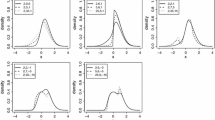Abstract
In this article, we introduce a new three-parameter skewed distribution of which normal distribution is a special case. This distribution is obtained by using geometric sum of independent identically distributed normal random variables. We call this distribution as the geometric skew normal distribution. Different properties of this new distribution have been investigated. The probability density function of geometric skew normal distribution can be unimodal or multimodal, and it always has an increasing hazard rate function. It is an infinite divisible distribution, and it can have heavier tails. The maximum likelihood estimators cannot be obtained in explicit forms. The EM algorithm has been proposed to compute the maximum likelihood estimators of the unknown parameters. One data analysis has been performed for illustrative purposes. We further consider multivariate geometric skew normal distribution and explore its different properties. The proposed multivariate model induces a multivariate Lévy process, and some properties of this multivariate process have been investigated. Finally, we conclude the paper.
Similar content being viewed by others
References
Arnold, B.C. and Beaver, R.J. (2000), “Hidden trucation models”, Sankhya, Ser. A, vol. 62, 23 - 35.
Arnold, B.C. and Beaver, R.J., Groeneveld, R.A. and Meeker, W.Q. (1993), “The nontruncated marginal of a truncated bivariate normal distribution”, Psychometrika, vol. 58, 471–488.
Azzalini, A.A. (1985), “A class of distributions which include the normal”, Scandinavian Journal of Statistics, vol. 12, 171–178.
Azzalini, A.A. and Dalla Valle, A. (1996), “The multivariate skew normal distribution”, Biometrika, vol. 83, 715–726.
Barreto-Souza, W. (2012), “Bivariate gamma-geometric law and its induced Levy process”, Journal of Multivariate Analysis, vol. 109, 130–145.
Bjerkedal, T. (1960), “Acquisition of resistance in guinea pigs infected with different doses of virulent tubercle bacilli”, American Journal of Hygiene, vol. 72, 130–148.
Johnson, N.L., Kotz, S. and Balakrishnan, N. (1995), Continuous Univariate Distribution, Volume 1, John Wiley and Sons, New York, USA.
Johnson, R.A. and Wichern, D.W. (1992), Applied Multivariate Statistical Analysis, Prentice Hall, New Jersey, USA.
Gupta, R.C. and Gupta, R.D. (2004), “Generalized skew normal model”, TEST, vol. 13, 1–24.
Kuzobowski, T.J. and Panorska, A.K. (2005), “A mixed bivariate distribution with exponential and geometric marginals”, Journal of Statistical Planning and Inference, vol. 134, 501–520.
Kuzobowski, T.J., Panorska, A.K. and Podgorski, K. (2008), “A bivariate Levy process with negative binomial and gamma marginals”, Journal of Multivariate Analysis, vol. 99, 1418–1437.
Louis, T.A. (1982), “Finding the observed information matrix when using the EM algorithm”, Journal of the Royal Statistical Society, Ser. B, vol. 44, 226– 233.
Self, S.G. and Liang, K-L. (1987), “Asymptotic properties of the maximum likelihood estimators and likelihood ratio test under non-standard conditions”, Journal of the American Statistical Association, vol. 82, 605–610.
Author information
Authors and Affiliations
Corresponding author
Rights and permissions
About this article
Cite this article
Kundu, D. Geometric Skew Normal Distribution. Sankhya B 76, 167–189 (2014). https://doi.org/10.1007/s13571-014-0082-y
Received:
Revised:
Published:
Issue Date:
DOI: https://doi.org/10.1007/s13571-014-0082-y
Keywords
- Characteristic function
- Moment generating function
- Infinite divisible
- Maximum likelihood estimators
- EM algorithm
- Fisher information matrix
- Lévy process




